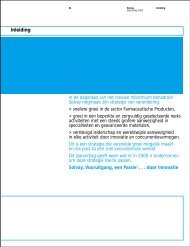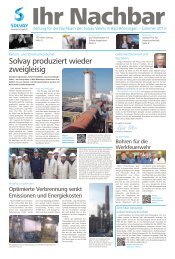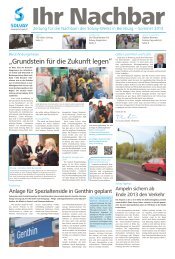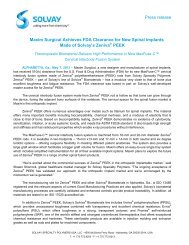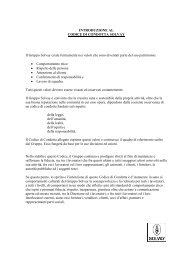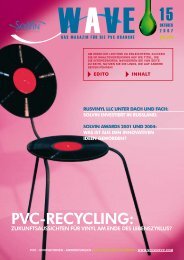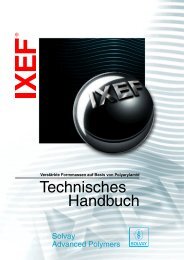Form 20-F 2005
Form 20-F 2005
Form 20-F 2005
Create successful ePaper yourself
Turn your PDF publications into a flip-book with our unique Google optimized e-Paper software.
Recognition of past service costs related to benefits that have been vested<br />
Under U.S. GAAP, these costs are amortized over the remaining service periods of active employees. Under IFRS, these costs<br />
are immediately recognized in income.<br />
Limitations on recognizing pension assets<br />
Under U.S. GAAP, there is no limitation on the amount of pension assets that can be recognized. Under IFRS, pension assets<br />
cannot be recognized in excess of the net total of unrecognized past service cost and actuarial losses plus the present value of<br />
benefits available from refunds, or reductions of future contributions to the plan.<br />
(ii) Goodwill and indefinite-lived intangible assets<br />
U.S. GAAP and IFRS both required the cessation of the amortization of goodwill and indefinite-lived intangible assets with<br />
the replacement of periodic tests of the impairment of these assets. The carrying value of goodwill and indefinite-lived intangible<br />
assets at January 1, <strong>20</strong>02 for U.S. GAAP and at January 1, <strong>20</strong>04 for IFRS are no longer amortized.<br />
Under U.S. GAAP, a two-step process is required in the event of goodwill impairment. The first step screens for potential<br />
goodwill impairment by comparing the fair value of the reporting unit, generally based on discounted cash flows expected to be<br />
received from the reporting unit, with its carrying value. The second step, which is only performed if the carrying value of the reporting<br />
unit exceeds its fair value, measures the amount of goodwill impairment by comparing the difference between the reporting unit’s<br />
implied fair value of goodwill with the carrying value of its goodwill. The implied fair value of goodwill is calculated by fair valuing the<br />
reporting unit’s assets and liabilities and comparing the result with the fair value of the reporting unit. Under IFRS, the impairment<br />
of goodwill is tested along with tangible and other long-lived assets. An impairment loss is recognized if the carrying value of the<br />
cash-generating unit or group of cash-generating units (defined as the smallest identifiable group of assets that generates cash<br />
inflows that are largely independent of the cash inflows from other assets or groups of assets) exceeds its recoverable amount,<br />
which is determined as the difference between its carrying value and the higher of its fair value or value in use, generally based on<br />
the discounted cash flows expected to be received from the cash-generating unit or group of cash-generating units.<br />
Under U.S. GAAP, goodwill impairments tests are performed after tangible and other long-lived assets have been tested<br />
for impairment. If these tangible and other long-lived assets are impaired, then they are adjusted to fair value, generally based<br />
on discounted cash flows expected to be received from the reporting unit, which will impact the amount of goodwill impairment.<br />
Under IFRS, goodwill impairment is recognized initially until it is fully written-off before tangible and other long-lived assets are<br />
impaired.<br />
(iii) Capitalized development costs<br />
Under U.S. GAAP, development expenses are expensed when incurred. Under IFRS, development expenses that meet specific<br />
criteria are capitalized in other intangible assets and are amortized over their estimated useful lives. Capitalized expenditures include<br />
personnel costs, material costs and services used that are directly assigned to the projects concerned.<br />
(iv) Tangible and other long-lived asset impairments<br />
U.S. GAAP and IFRS both require periodic tests of the impairment of tangible and other long-lived assets if there are any<br />
indications of impairment. Under U.S. GAAP, an impairment loss is recognized if the carrying value of an asset or asset group (defined<br />
as the lowest level of asset or group of assets for which identifiable cash flows are largely independent of the cash flows of other<br />
assets or groups of assets) exceeds the undiscounted cash flows expected to be received from the asset or asset group. If this<br />
condition exists, then the amount of the impairment loss is determined by the difference between the carrying value of the asset or<br />
asset group and its fair value, generally based on the discounted cash flows expected to be received from the asset or asset group.<br />
Under IFRS, an impairment loss is recognized if the carrying value of the cash-generating unit (defined as the smallest identifiable<br />
group of assets that generates cash inflows that are largely independent of the cash inflows from other assets or groups of assets)<br />
F-86 <strong>Form</strong> <strong>20</strong> - F <strong>20</strong>05 - Rhodia



